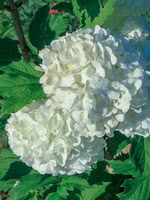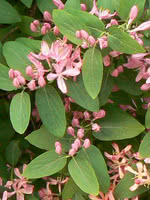Mon-Fri 9am - 5pm Mountain time
Snowball Viburnum vs Twining Honeysuckle
Viburnum opulus roseum
Lonicera dioica
CUSTOM GROW
Snowball Viburnum is a popular ornamental shrub with prolific flowering. This plant is prized for its round clusters of white flowers that resemble snowballs, delighting children and adults. In fall, its leaves turn vibrant shades of red.
Snowball Viburnum is sought after as a single accent shrub, but can also make a dense hedge or privacy screen.
Twining Honeysuckle is a vine native to the forests of Canada and the United States.
It can often be found winding up the bark of large trees or spreading out as a ground cover where no supports are present. You will love the attractive, yellow-orange flowers with pink centers which turn into red, inedible berries.
Consider Twining Honeysuckle when trying to achieve a natural, spreading, unkempt look for your garden.

